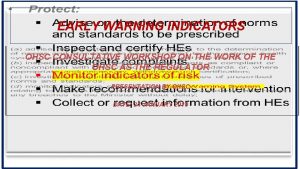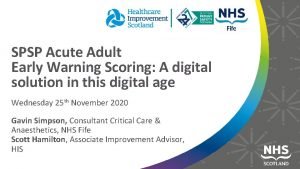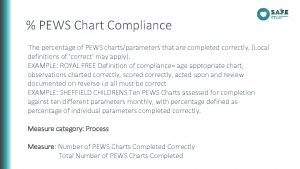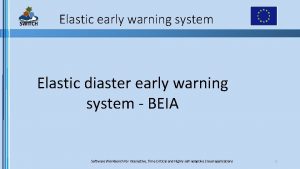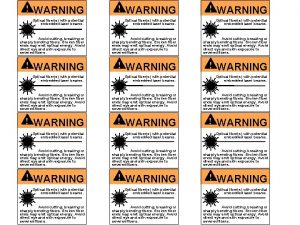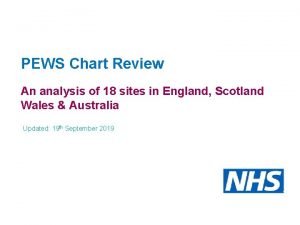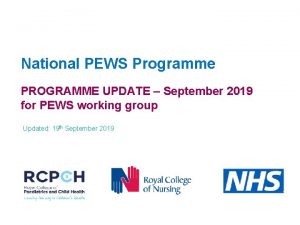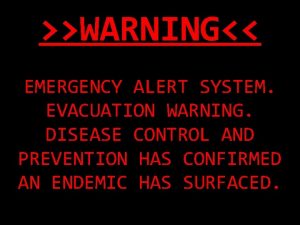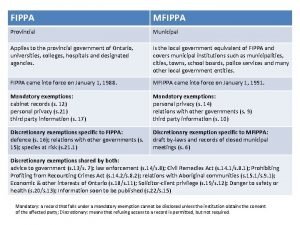Pediatric Early Warning System PEWS A Provincial Approach


















- Slides: 18

Pediatric Early Warning System (PEWS) A Provincial Approach

Who is Child Health BC? A provincial networking collaboratively to build an integrated, accessible system of health services for children and youth. ü All 7 Health Authorities, including First Nations HA ü UBC Department of Pediatrics ü The three child serving ministries (Mo. E, MCFD & Mo. H) ü Research (Maternal Infant Child Youth Research Network) ü BC Pediatric Society ü Doctors of BC ü Society of General Practitioners of BC 2

What are we trying to achieve? Creation of a planned, rational system of health services for children & youth in BC. 3

What is PEWS? AN EVIDENCED-INFORMED CLINICAL TOOL ü Identifies children as soon as possible, who are at risk of clinical deterioration. ü Mitigates risk through clinical and procedural response ü Provides escalation of care guidance ü Provides a common language and communication framework to standardize care for children across the Province

Why use a PEWS? ü~63 to 89% of children do not survive cardiac arrest üMorbidity in survivors remains high despite advances üPediatric patients may demonstrate symptom deterioration up to 24 hours prior to cardiopulmonary arrest üEarly recognition offers a window of opportunity to intervene for improved outcomes. üEvidence indicates prevention is possible

A Case for Change ü Used internationally for over 10 years ü Identified as a high priority by Health Authorities. ü Child Health BC has been working with BCCH and Health Authority Pediatric Planners to develop a PEWS system that will work across the province

The Challenge 95 -98% of adverse events are due to system failures 1 ü Healthcare is optimized when systems work seamlessly ü This is achieved by empowering all members of the team to make the safest decision for every patient ü The challenge is maintaining a strong network of care Improving the systems through which healthcare is delivered is fundamental to reducing clinical error

The Solution P E W S ediatric arly arning ystem Creating safety requires changing the conditions in which people work

Benefits of a Provincial Approach ü Promotes a consistent standard of care for pediatric patients across BC ü Provides a common language and benchmark for pediatric care ü Utilizes expertise and resources efficiently to develop evidence informed standards ü Facilitates safe transitions 12/11/2021 9

Purpose of PEWS üIdentify pediatric patients who are at risk of deterioration üMitigate the risk (through clinical and procedural response) üEscalate to a higher level of care if mitigation is unsuccessful … and do it all sooner!

Components of the PEWS Situational awareness bundle Score (bedside flowsheet) Escalation protocol Communication framework (SBAR)

Where is PEWS used? üCommon in the US, UK, Australia, Canada üMany tools, most adapted from the Brighton tool üPrimarily used in pediatric and general inpatient units üSome modification for emergency departments and cardiac units. ü Limited reported use in post operative recovery

PEWS Is: Is not: ü A support to good clinical ü A substitute for clinical judgment ü Red flag of potential/established critical illness ü Generally sensitive depending upon its complexity ü An aid to effective communication judgment ü A comprehensive clinical assessment tool ü An indicator for immediate admission to ICU ü A replacement for CTAS

PEWS research has found… üNearly 50% decrease in rates of UNSAFE ICU transfers üPotentially provides leeway time of >11 hours üPositive directional trends in improved clinical outcomes üEnhanced inter-disciplinary team work, communication and confidence üThere are no negative outcomes reported in the literature related to the use of PEWS

CHBC PEWS Implementation Plan Phase 1 Outputs üA literature review üA provincial standardized System which includes: §PEW Score imbedded in flow sheet, §Situational awareness bundle, §Communication framework (SBAR) and §Escalation protocol üAn education strategy üAn evaluation strategy 15

CHBC PEWS Implementation Plan Phase 2 Outputs üImplementation in inpatient general and pediatric units at 14 sites in BC üPilot in Emergency department and Pediatric Short Stay Unit at Richmond General Hospital ü Provision of education at all 15 sites üEvaluation üPlan for spread 16

Roles and Responsibilities CHBC HAs ü Provide leadership and ü Support and collaborate ü Approve at HAMAC and project management support Quality ü Support development of ü Build PEWS into ongoing PEWS system incl. guidelines, protocols and provincial documentation ü Support education of trainers, clinical staff and physicians ü Support evaluation operations ü Ensure clinical staff working with children maintain pediatric skills ü Develop site escalation protocols

Thank you and Questions Who to contact for information? • Place contacts for your agency/health authority here.
 Icews
Icews Early warning intervention and monitoring system
Early warning intervention and monitoring system Early warning system in disaster management
Early warning system in disaster management Ohsc early warning system
Ohsc early warning system Ohsc early warning system
Ohsc early warning system Earthquake early warning systems
Earthquake early warning systems Brighton early warning scoring system
Brighton early warning scoring system Early warning attrition tracker model
Early warning attrition tracker model Sri lanka tsunami warning system
Sri lanka tsunami warning system Mews early warning system
Mews early warning system Maternity early warning score chart
Maternity early warning score chart Balistic missle
Balistic missle Early warning score
Early warning score Early warning score
Early warning score Earthquake early warning systems
Earthquake early warning systems News vitalparametrar
News vitalparametrar How much does arimidex increase survival
How much does arimidex increase survival Nec activity schedule example
Nec activity schedule example Fife early warning score
Fife early warning score



